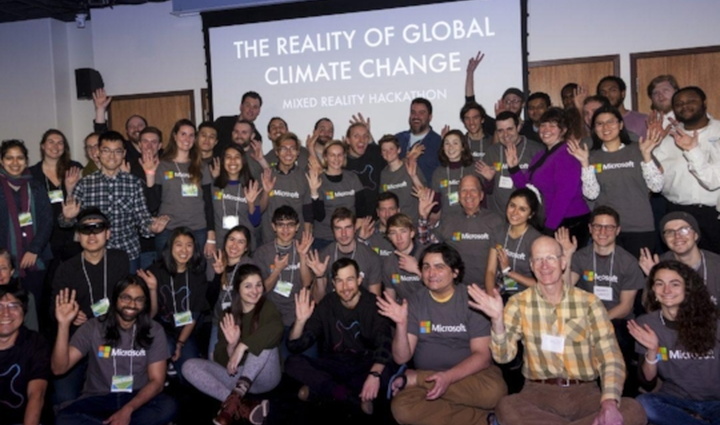Hackathon Uses Virtual Reality to Explore Global Climate Change
Chaos engulfed the Center for Collaborative Arts and Media (CCAM) on the evening of February 9, 2018. The participants in The Reality of Global Climate Change Hackathon were busy getting into teams, brainstorming ideas, and even starting work. By the next day, each team was to present an experience using virtual reality that addressed one of four prompts relating to the effects of climate change.

Given the limited time frame and the challenge of using VR, both the first- and third-place teams decided on a necessary condition for success: the project must feel both urgent and personal.
The first-place team—made up of Tevin Mickens, Jack Wesson, Daniela Schulman, Nate May and Bobby Berry—created a game called “Climb-It” (a pun that Jack says prompted groans when he first proposed it). It was important to them that they do more than simply create a three-dimensional representation of the data; they wanted the user to interact with it.
“We had people physically be in a map that Tevin designed, and it was a really big, life-size map in this metal silo filling up with water,” Jack describes. “Your goal was to stop the water from flowing out.”
Nate adds, “The water was flowing from pipes coming out from individual countries, and the width of the pipe and the water flow was proportional to the amount of emissions that that country emitted. You had to go up and plug the pipes by picking up a [cutout of a] country from the floor and climbing the wall and just sticking it in the pipe. You had to do that before the silo filled up with water.”
The rush of water helped them establish urgency, but they still needed a narrative that the user could connect with. Nate and Dani provided the solution.
“Nate created this incredible soundscape that you’re engulfed in when you’re in the game,” Dani says “You’re hearing the sound of rushing water, and then once you pick up a country, it starts to change and morph out of the sound of water and becomes a cascade of whispers. Eventually those whispers channel into one single voice. The idea is, if this were in a perfect world, with tons of time to develop it, it would be someone from that country sharing a story of their climate reality.”
Because they had limited time, Nate recorded Dani whispering stories she mined from the internet. The effect was not lost.
“It was easily the most compelling part of this project,” Jack says. “The whispers actually chill you to the bone. I got goosebumps hearing it the fiftieth time.”
The third-place team, composed of Wlad Woyno and Michael Costagliola, followed a similar line of thinking.
“We’re from the School of Drama,” Michael explains, “so we wanted to create something that had some kind of emotional impact or emotional narrative. We created this ocean, a seascape. It’s just really frightening. We had thought about the sea levels rising, but we were more interested in this feeling of sinking and drowning.”
They called their project “The Big Sink.”
“In VR, it’s more visceral, and you know it’s fake, but it triggers those primal reactions,” Michael adds. “So that’s what we were going for with this feeling of drowning. It’s this inevitable, slow sink that you can’t control or stop when you enter this world.”
Just like the water filling up the silo in Climb-It, the Big Sink demonstrated just how immediate and nearly unstoppable the progress of climate change is.
Michael and Wlad also recognized the importance of an immersive sensory experience.
“As you’re sinking,” Wlad says, “you’re looking at where you are, and you essentially sink through the decades. In each one, it gets progressively worse, clearly, but you can experience that as you’re falling. I think another aspect that the judges really appreciated was that we didn’t only have this visual representation, but we also had something a bit more experiential than just doing data displays. Michael did this sonification of the data based on changing temperatures.”
Capturing both the change in greenhouse gas emissions and the change in global temperature, Wlad and Michael sent their user down through the rising ocean and inundated them with a rising sound, “like a tea kettle boiling over.”
Both teams succeeded in portraying an emergent and personal arc of climate change. The first- place team hopes to upload their project, which they’re continuing to work on, to the CCAM computers so that others can see what VR can do. They’re also eager to praise the CCAM for its resources.
“I think the CCAM is only just starting to get the recognition and the use that it deserves,” Dani says. “It could be utilized so much more.”
It’s not just technology for technology’s sake either, she insists.
“It was cool to actually use technology to be an educational tool or a medical tool or something that’s doing a genuine good,” Dani adds, “and that was really fun about this project because all of the teams were trying to use this thing to make a real difference.”
Both teams, fresh of their recent success, are keen on participating in another hackathon.
“Oh absolutely!” Jack says. “We have to reassemble the Avengers!”
Emma Chanen is the Digital Media Intern at Tsai CITY.